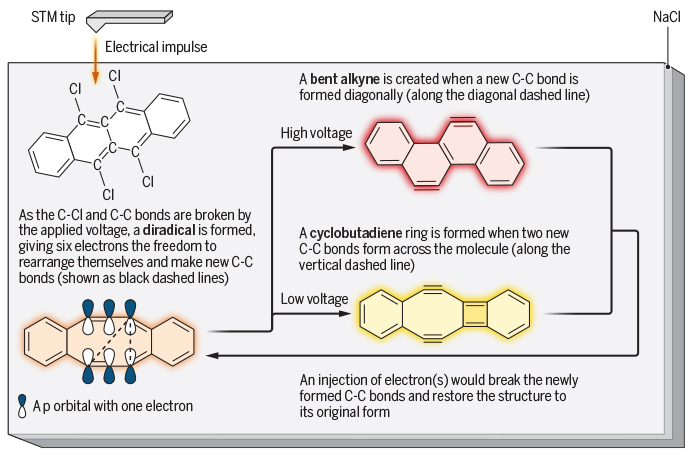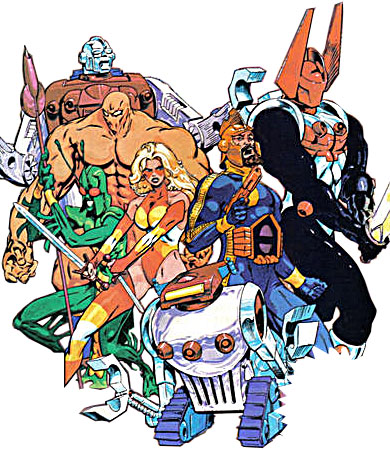
Posted on 07/18/2022 9:03:25 AM PDT by Red Badger

Bent alkyne (left), diradical (center) and cyclobutadiene molecules under atomic force microscopy. (Leo Gross/IBM)
If chemists built cars, they'd fill a factory with car parts, set it on fire, and sift from the ashes pieces that now looked vaguely car-like.
When you're dealing with car-parts the size of atoms, this is a perfectly reasonable process. Yet chemists yearn for ways to reduce the waste and make reactions far more precise.
Chemical engineering has taken a step forward, with researchers from the University of Santiago de Compostela in Spain, the University of Regensburg in Germany, and IBM Research Europe forcing a single molecule to undergo a series of transformations with a tiny nudge of voltage.
Ordinarily, chemists gain precision over reactions by tweaking parameters such as the pH, adding or removing available proton donors to manage the way molecules might share or swap electrons to form their bonds.
"By these means, however, the reaction conditions are altered to such a degree that the basic mechanisms governing selectivity often remain elusive," the researchers note in their report, published in the journal Science.
In other words, the complexity of forces at work pushing and pulling across a large organic molecule can make it hard to get a precise measure on what's occurring at each and every bond.
The team started with a substance called 5,6,11,12-tetrachlorotetracene (with the formula C18H8Cl4) – a carbon-based molecule that looks like a row of four honeycomb cells flanked by four chlorine atoms hovering around like hungry bees.
Sticking a thin layer of the material to a cold, salt-crusted piece of copper, the researchers drove the chlorine-bees away, leaving a handful of excitable carbon atoms holding onto unpaired electrons in a range of related structures.

Diagram of isomers reconfigured by stm
A single molecule reconfigured into isomers (Alabugin & Hu, Science, 2022)
Two of those electrons in some of the structures happily reconnected with each other, reconfiguring the molecule's general honeycomb shape. The second pair were also keen to pair up not just with each other, but with any other available electron that might buzz their way.
Ordinarily, this wobbly structure would be short-lived as the remaining electrons married up with each other as well. But the researchers found this particular system wasn't an ordinary one.
With a gentle push of voltage from an atom-sized cattle prod, they showed they could force a single molecule to connect that second pair of electrons in such a fashion that the four cells were pulled out of alignment in what's known as a bent alkyne.
Shaken a little less vigorously, those electrons paired up differently, distorting the structure in a completely different fashion into what's known as a cyclobutadiene ring.
Each product was then reformed back into the original state with a pulse of electrons, ready to flip again at a moment's prompting.
By forcing a single molecule to contort into different shapes, or isomers, using precise voltages and currents, the researchers could gain insight into the behaviors of its electrons and the stability and preferable configurations of organic compounds.
From there it could be possible to whittle down the search for catalysts that could push a large-scale reaction of countless molecules in one direction, making the reaction more specific.
Previous studies have used similar methods to visualize the reconfigurations of individual molecules, and even manipulate individual steps of a chemical reaction. Now we are building new methods for tweaking the very bonds of molecules to form isomers that ordinarily wouldn't be so simple to swap around.
Not only does research like this help make chemistry more precise, it provides engineers with sharp new tools to manufacture machines on a nanoscale, warping carbon-frameworks into exotic shapes that wouldn't be possible with ordinary chemistry.
This research was published in Science.
Hugh and Series?????
Better living through chemistry......................
As long as a moose isn’t involved as they have a nasty bite. Just ask my sister.
Will this discovery help stop wicked Climate Change? If not, all the scientists involved should be censored for their indifference to Mother Earth.
Side note to Red: In all seriousness, thanks for posting this. My first degree was in Chemistry. And even though that was a lifetime ago I still very much enjoy reading about it.
Zig! For great Justice
Thanks.
This isn’t quite ‘transmutation’ but it’s getting close.
Imagine being able to change molecular structures with just applied voltages at certain critical times to get a different type of isomer.
The prospects are endless....................
As Ralph Kramdem might say, “One of these days, Alice, one of these days ... KABOOM.”
And there goes the planet.
Scaling may be an issue.
Can they do this to create gold in a lab?
A disturbance in the force has been felt.
I would think this is the beginning of what we are going to see with small nuclear applications.
It would be endless if you could have small nuclear reactors in the neighborhood with regard to providing energy or just think a small nuclear reactor to run in your car.
The application medically would have to be tremendous also
Not yet, just rearrange the atoms in a molecule...............It’s a start................
Vary hugh...
Haven’t Blacksmiths been doing this for a long, long time?
Yeah, looks like they really stuned it.
A fine deadpan post.
Is there any phase of matter that includes free floating quarks that can be combined into new protons and neutrons?

He's my cousin. Family doesn't talk about it much.
Disclaimer: Opinions posted on Free Republic are those of the individual posters and do not necessarily represent the opinion of Free Republic or its management. All materials posted herein are protected by copyright law and the exemption for fair use of copyrighted works.